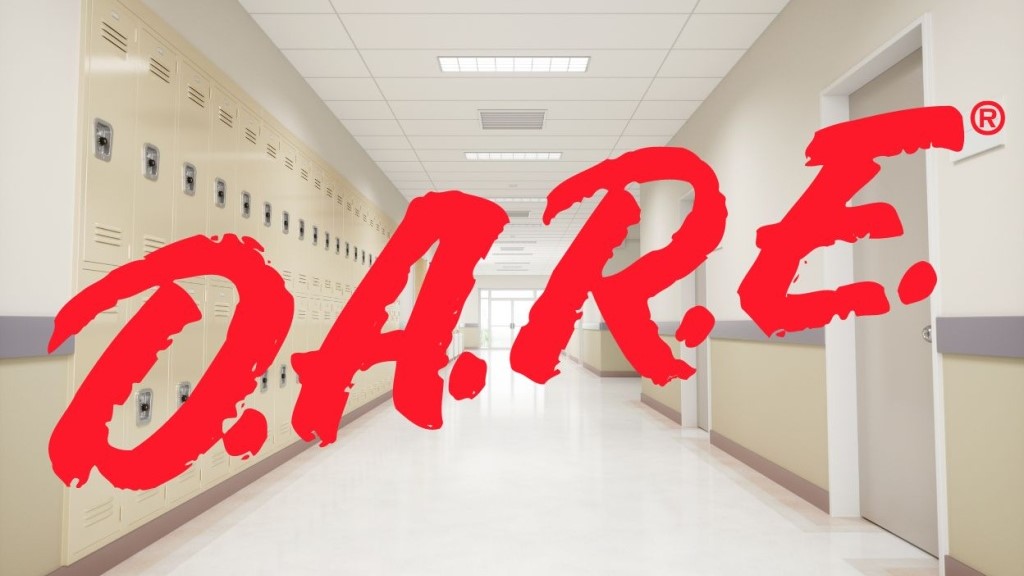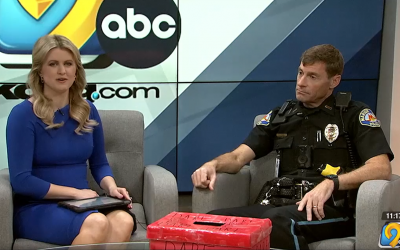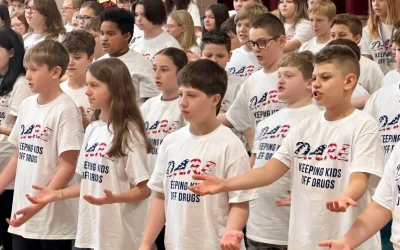Now, those born from 1981 to 1996 (aka Millennials) are raising many of the kids now going through D.A.R.E. In the ‘90s and very early aughts, the D.A.R.E curriculum was considered cutting edge, and prevention was the name of the game. But D.A.R.E. director of curriculum and training, Dr. Ashley Frazier, wants the new class of adults to know that the program is a far cry from the 1990s iteration.
Frazier explained to GreenState that for some risk-averse kids, displaying the results of drug abuse puts them off the stuff; but for others, it could do the opposite. Turns out, showcasing drugs and their effects might not teach prevention, but rather build interest. Maryland D.A.R.E. Coordinator and Officer Mike Casamento weighed in as well in a statement sent to GreenState.
“We don’t tell kids to ‘just say no’ and have a drug ‘show and tell’ anymore. This new curriculum was science-backed and evidence-based in prevention sciences,” Casamento shared.
The history and the new D.A.R.E.
The D.A.R.E. program was founded in Los Angeles, Calif., as a partnership between the Los Angeles Unified School District (LAUSD) and the Los Angeles Police Department (LAPD). At that time, the curriculum focused on individual substances. The drug-by-drug prevention lesson covered cannabis alongside heroin, alcohol, and other substances.
D.A.R.E. adopted an evidence-based program developed at Penn State rather than building a new one from scratch in the advent of the 2010s. This program became known as Keepin’ it REAL. The modern D.A.R.E sequence reaches young people in three parts:
- Elementary D.A.R.E. program
- keepin’ it REAL in middle school
- Four core sessions for high school students
Rather than teaching outward lessons, D.A.R.E. officers hold space for the kids and teens to talk about drugs and peer pressure as the present in their lives. No lectures—just activities, discussions, and facilitation that center on what’s impacting the kids’ lives.
“The colloquialism we use is ‘by kids, through kids, for kids.’” Casamento said. “We keep it kid-centric and focus on what can and may be happening in their lives to reinforce what we are teaching them. Now, we teach kids how to look at a problem, identify their choices, weigh the risks and consequences, and make a decision based on the information they have gathered”
The D.A.R.E. high school program was a postdoctoral project for Frazier before she accepted a full-time position at the nonprofit. She explained more about this effort to move away from the “Just Say No” refusal method and lectures about substances. The focus is now on facilitating kids in acquiring risk-management skills and decision-making while remaining steadfast in holding personal boundaries.
“Humans don’t lack information; there’s so much information available to people about things, skills, and behaviors that really matter. We really go on the idea (with the curriculum) that kids have most of the information they need,” she explained. “The focus is on your safety, health, and wellness; what decisions do you want to make about your life?”
Cannabis and D.A.R.E.
With the new curriculum, there’s no longer a marijuana presentation or lecture. The plant would only come up if the kids want to speak about it–participants guide the discussion. This is partially because attitudes about cannabis differ from state to state, school to school, and family to family. Rather than being trained to implement one curriculum for every student, officers meet students where they are.
Kids are taught to identify risks, understand outcomes if they take the risk, and practice responses if offered drugs or alcohol. The last step is to evaluate, which teaches self-awareness, inspiring students to look at their past choices and figure out what worked and what didn’t, and how that might shape future decisions.
Rather than asking kids to “Just Say No,” as past generations learned, today’s D.A.R.E. participants are building risk management tool belts. The kids gain applicable ways to maintain friendships and engage with social events in complicated spaces like high school without feeling they have to partake in binge drinking, joint passing, or other risky activities if they don’t want to.
“It’s really based in prevention science because I think the other thing that we’ve learned is that things are multi-factored; there’s like a bunch of mediators that go into risk. You don’t have D.A.R.E., and you’re inoculated; D.A.R.E. is part of a giant context of people’s lives and messages have to happen appropriately for your emotional level,” Frazier said.
D.A.R.E. programs and the greater message
The D.A.R.E. program hopes kids and teenagers learn tools to take out to parties, park hangs, and other places where the underaged tend to get high or drunk through self-guided discussion. Trained officers give them skills to make choices that align with their goals but also maintain friendships with those who make different decisions.
The curriculum no longer includes drug-by-drug education but instead collaborative sessions in setting boundaries and practicing mindful awareness–skills many Millennials are learning as adults in therapy.
Like most things, the D.A.R.E. program has evolved in the last three decades, but the goal has remained the same.
“At the heart of every D.A.R.E. officer, I think, is this goal to make a difference. We just don’t dare to keep kids off drugs anymore—we want to help kids live safe and healthy lives by helping them make better decisions…If I have the opportunity to save one kid from a life of substance abuse or being hurt by risky behavior, I feel that I have succeeded in what we are trying to accomplish,” Casamento concluded.
Marion police officer talks about D.A.R.E. classes
From KCRG.com: Marion Police Officer Tom Daubs joins KCRG to talk about D.A.R.E. classes
Key Addiction Points You Need to Know
Substance use disorder (SUD) is the nation’s most pressing public health challenge, and the most urgent SUD in 2024 is opioid abuse and dependency. According to the CDC, more than one million people have died since 1999 from drug overdose…
Old Lyme Officer Revives D.A.R.E. Program After Two Decades Hiatus
Officer Stephen Hackett of the Old Lyme Police Department is set to become the town’s first Drug Abuse Resistance Education (D.A.R.E.) instructor in over two decades. With a new focus on skill-building, the updated D.A.R.E. program aims to empower the town’s youth to make responsible choices.
Mental Health Stigma: Life or Death
The pervasive stigma against people with addictions, particularly opioid use disorder (OUD), is a major problem requiring urgent attention in the United States. Stigma is likely at least part of the reason why only 1 in 5 individuals with opioid dependence receives…
Former YAB Member and D.A.R.E. Scholarship Awardee Julia Manning is now a Police Officer for the Park Ridge Police Department
Julia Manning was an active member of the YAB (Youth Advisory Board) from 2016 to 2019, and she is now proud to be an alumni of the program. In recognition of her outstanding achievements, she was honored with the prestigious 2019 D.A.R.E. America Louis 'Skip' Miller...
150-Plus Students Graduate Russell D.A.R.E. Program
Russell Elementary students graduated from the D.A.R.E. program at Russell-McDowell Intermediate School on Monday. About 153 fifth-grade students — all wearing white shirts that read “keep kids off drugs” — filled the gymnasium early afternoon Monday to be recognized...
Students Graduate from D.A.R.E. Program at Mary Queen of Peace
Four classes at Mary Queen of Peace in Mount Pearl have graduated from the RNC’s Drug Abuse Resistance Education program. The ten-week series of classroom lessons, led by an RNC officer to grade six students, teaches children how to live productive drug-free and...
Hundreds of Students Graduate from MPD’s D.A.R.E. Program
MEMPHIS, Tenn. — Memphis Police celebrated with hundreds of local students as they graduated from the D.A.R.E. program Wednesday. For 40 years, D.A.R.E. has been teaching children about the dangers of high-risk situations with alcohol, drugs, and bullying. MPD…
D.A.R.E. Makes a Comeback in Chino Schools
The drug abuse resistance program D.A.R.E. has returned to Chino elementary schools after 20 years, with a focus on healthy decision-making skills and self-advocacy. Approximately 900 fifth-grade students in the Chino Valley Unified School District are participating…









